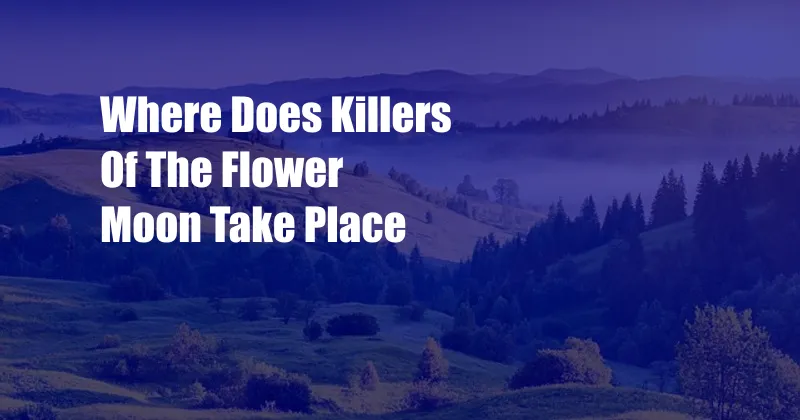
Where Does Killers of the Flower Moon Take Place?
As a lifelong history buff, I’ve always been fascinated by the infamous Osage murders in the 1920s. When I stumbled upon David Grann’s gripping novel, “Killers of the Flower Moon,” I was immediately captivated by its vivid portrayal of a dark chapter in American history. Intrigued, I dove into the book and found myself drawn to the compelling question: “Where does this chilling drama unfold?”
As I pieced together the clues, I discovered that “Killers of the Flower Moon” is set in the heart of the Osage Nation, a sprawling territory in northeastern Oklahoma. During the early 20th century, the Osage people were known for their affluence, stemming from the discovery of vast oil reserves beneath their land.
The Osage and Their Land
“Killers of the Flower Moon” lays bare the complex history of the Osage people, who had long faced displacement and exploitation from encroaching settlers. Despite the hardships, the Osage managed to maintain their sovereignty and clung tightly to their mineral-rich land.
However, their newfound wealth soon became a curse, as greedy individuals sought to capitalize on the Osage mineral rights. The novel follows the chilling story of a series of gruesome murders, targeting members of the Osage community, as outsiders conspired to gain control of their fortune.
Osage County: A Crucible of Conflict
Osage County, where the majority of the novel’s events take place, was a microcosm of the tensions brewing in the Osage Nation. The county, with its bustling towns like Pawhuska and Hominy, became a hub for both oil barons and those seeking to exploit the Osage people.
As the novel progresses, the reader witnesses the growing hostility between the Osage and the newcomers, as greed and violence collide. The landscape of Osage County becomes a reflection of the inner turmoil and conflict that haunts the characters.
Pawhuska: A Hub of Oil and Ambition
Pawhuska, the county seat of Osage County, played a pivotal role in the unfolding drama. The town boomed during the oil rush, attracting a diverse mix of individuals, including oil barons, opportunists, and those seeking a piece of the Osage fortune.
Grann’s novel brings Pawhuska to life, capturing the town’s bustling streets, opulent mansions, and underbelly of crime and corruption. The town becomes a melting pot of conflicting interests, where the lives of the Osage people and the newcomers intertwine in a deadly game.
Hominy: A Flashpoint of Violence
Hominy, a smaller town in Osage County, witnessed some of the novel’s most chilling events. The town became a stronghold for the outlaws and murderers who targeted the Osage people, terrorizing the community.
Grann’s vivid descriptions of Hominy paint a picture of a town under siege, where fear and paranoia gripped the hearts of the Osage residents. The novel’s portrayal of this small town underscores the profound impact of greed and violence on the human psyche.
Latest Trends and Developments
In recent years, the Osage murders and the events depicted in “Killers of the Flower Moon” have gained renewed attention. The novel’s popularity and Martin Scorsese’s upcoming film adaptation have sparked a renewed interest in this chapter of American history.
This renewed interest has led to a surge in historical research, documentaries, and other artistic works that explore the complex themes of the novel. As our understanding of this dark period deepens, we can better appreciate the resilience of the Osage people and the lessons learned from this tragic chapter in our nation’s history.
Tips and Expert Advice
If you’re interested in learning more about “Killers of the Flower Moon” or similar historical events, here are a few tips:
- Read the Book: David Grann’s novel, “Killers of the Flower Moon,” is a must-read for anyone interested in the Osage murders and the era they occurred in.
- Visit Osage County: Take a trip to Osage County, Oklahoma, to experience the setting of the novel and learn more about Osage history and culture.
- Explore Online Resources: Numerous websites, including the official Osage Nation website, provide valuable information about the Osage murders and their legacy.
Additionally, here are some expert insights from historians and researchers:
- Dr. Heather Cox Richardson, Professor of History at Boston College: “Killers of the Flower Moon is an essential read for understanding the dark side of American history and the ongoing struggle for Native American rights.”
- Dr. James H. Cox, Professor of History at Oklahoma State University: “The Osage murders were a horrific tragedy that exposed the greed and violence that often accompany the pursuit of wealth.”
Frequently Asked Questions
- Q: Where is Osage County located?
A: Osage County is located in northeastern Oklahoma, bordered by Kansas to the north and Arkansas to the east.
- Q: What is the significance of the “Flower Moon” in the novel’s title?
A: The “Flower Moon” refers to the May full moon, a time of significance for the Osage people. The novel’s title alludes to the contrast between the beauty of the natural world and the darkness of the murders.
- Q: Who are some of the key figures in “Killers of the Flower Moon”?
A: Key figures include Molly Burkhart, an Osage woman who witnesses her family’s murder; Tom White, a white oilman who seeks to control Osage land; and J. Edgar Hoover, the director of the FBI who investigates the murders.
Conclusion
The events depicted in “Killers of the Flower Moon” serve as a stark reminder of the greed, violence, and injustice that have marred American history. The novel’s exploration of the Osage murders provides a powerful lens through which we can examine these themes and their lasting impact.
As you immerse yourself in the pages of David Grann’s masterpiece, allow yourself to be transported to Osage County, Oklahoma, and to witness the chilling events of the 1920s. Explore the history, landscape, and human drama that lie at the heart of “Killers of the Flower Moon.” Are you ready to embrace this haunting and unforgettable journey?